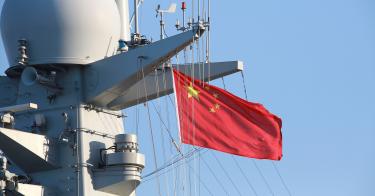On Friday, August 4, eleven Chinese and Russian naval vessels sailed near the U.S. Aleutian Islands in Alaska, leading the Navy to dispatch four destroyers and a P-8 maritime patrol aircraft to monitor the formation. “This is unprecedented,” remarked U.S. Senator Dan Sullivan (R-AK), “not just for Alaska, but for America to have 11 warships jointly being operated by the Chinese and Russians—who are increasingly working together—essentially doing freedom of navigation and navigation operations incursions into Alaska’s area.”
The Arctic in Focus
The U.S. is an Arctic nation as much as it is an Atlantic or Pacific one. To defend American sovereignty in the high north, policymakers must not only do more to raise public awareness of security threats but also work to ensure that the U.S. is properly resourced to defend its national sovereignty. One immediate step that would help on both counts is for the Select Committee on the Chinese Communist Party to hold a public hearing on the threat from China in the region.
After all, this weekend’s joint flotilla is not the only recent blinking red wake up call for the U.S. in the Arctic. In July, China’s Polar Research Institute made the startling announcement that it plans to deploy listening devices “on a large scale in the Arctic Ocean,” having successfully field-tested the technology. That’s a serious cause for concern, considering that China has long utilized its supposed “scientific” work in the high north as a smokescreen for increasing its military awareness there.
>>> Probing Palau’s Waters: Chinese Ships Are Increasingly Active in the Pacific
In 2018, for example, China’s Polar Research Institute sought to purchase or lease an airport at Kemijärvi, in Finland’s Lapland region. The proposal was nixed after local authorities inquired as to the Ministry of Defense’s views. Chinese plans called for an extension of the runway to operate research flights to the north pole. Kemijärvi’s mayor explained: “The flight route would have also made observations possible over the Arctic Ocean and the Northeast Passage, which is an area of interest to both China and Russia.” Furthermore, the flight path would have taken Chinese planes conveniently over the Rovajärvi firing range, Finland’s main artillery range (and the largest in Europe) which just happened to be located west of Kemijärvi.
Not long after that incident, in 2019 the U.S. Department of Defense warned that “civilian research could support a strengthened Chinese military presence in the Arctic Ocean,” and even went as far as to say that this “could include deploying submarines to the region as a deterrent against nuclear attacks.” This warning directly reflects research published in Chinese journals on submarine operations in the Arctic, including one article titled: “Peridynamic Model for Submarine Surfacing through Ice.”
That’s why these new Chinese listening devices caused so much alarm: They will almost certainly be used to track American and allied submarines. Consider that the once secret sound surveillance system—a series of underwater acoustic arrays for tracking Soviet submarines that gave the U.S. and its allies a crucial edge during the Cold War—was “built under the cover of civilian oceanographic research.” China seems to be taking a page out of the same book.
The truth is, China has been ramping up its efforts to push its way into the Arctic for years. Last fall, at around the same time that Chinese spy balloons were starting reconnaissance over Alaska, Canada found four Chinese spy buoys in their Arctic waters. These buoys could have been being utilized to map the seabed, monitor ice thickness, or monitor submarine activity.
My organization raised concerns at the time over Chinese ambitions in the Arctic. But the Biden Administration didn’t heed our warnings. Now, Washington’s passive approach combined with the rapidly expanding gulf between China and its junior partner Russia seems to have convinced Xi that the time is ripe to push for a greater presence in the Arctic.
But that doesn’t change the fact that China’s closest point to the Arctic Circle is more than 800 nautical miles away. Which is to say that China, despite it’s absurd claims to be a “near-Arctic state, is naturally limited by the simple fact that it is not an Arctic nation. Because of this, Beijing has utilized a scatter shot approach to increasing its activity in the Arctic region: trying everything from scientific cooperation (whether genuine or not) and becoming an observer in the Arctic Council in 2013 (the world’s primary multilateral forum concerned with the Arctic region) to seeking out Arctic investments and building new icebreakers (China already has double the number of icebreakers as the U.S).
These efforts have produced mixed results. Power in the Arctic Council rests with member states not observers, and the forum itself faces an uncertain future after Russia’s second invasion of Ukraine. On the scientific road to the Arctic, China has likewise stumbled, only recently beginning to again send personnel to research stations located in Norway’s Svalbard archipelago, and Karholl, Iceland after a lengthy hiatus. Finland and Sweden recently ended scientific cooperation with China in their northern regions; similarly a 2017 Chinese proposal to build a satellite dish antenna ground station in Greenland went nowhere. In 2020, the Canadian government ended an attempted Chinese takeover of the Hope Bay gold mine in the Nunavut territory over security concerns. Chinese investments in nearly all the Arctic nations have fallen flat.
The glaring exception is investment in the Russian Arctic. For Beijing, all roads to Arctic influence run through Moscow, and over the past decade China has spent nearly $90 billion investing in Arctic resource extraction, mostly with its neighbor to the north. So far, however, The Arctic is one of the areas where Russia has been able to retain “the upper hand in its dealings with China,” and remains “wary of allowing China undue access to a region it deems critical to national security.”
But as the war against Ukraine drags on, Moscow’s position is deteriorating by the day. Blocked from working with western companies, Russia must now rely upon China to provide the technology and funding to develop energy and mining projects in its Arctic region. In return, Beijing reaps a multitude of rewards: a reliable stream of cheap energy, political influence in Moscow, and lucrative construction contracts for Chinese companies. All that adds up to an invaluable toe hold in the Arctic for Beijing.
This latest incident in the Aleutian Islands and the Polar Institute’s plans to install a series of listening devices only underscores what we already knew: China is feeling bullish about its ability to push its way into the Arctic. During this scorching hot August, U.S. policymakers would do well to sit up and take notice of what’s going on in the ice-cold north.
This piece originally appeared in 1945



